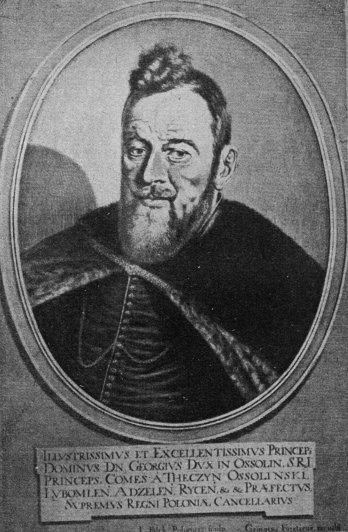Name Samuel Laszcz | ||
Samuel Łaszcz, Prawdzic Coat of Arms (1588–1649), famous nobleman in the Polish-Lithuanian Commonwealth, Starosta of Owrucz, Crown Grand Standard-bearer, Crown Great Guard (praefectus excubiarum seu vigiliarum), military commander and zagończyk(brave raider), infarmis(infamia) and outlaw, with family estate in Łaszczów. He was famous for his wit and quick smile, and allegedly introduced special men's haircut.
Contents
Military career
It is alleged that he started his military career at 17. Among many commander he fought under one of the most famous was Stefan Chmielecki with whom he practiced his military skills in the Dzikie Pola. He took part in the Khotyn campaign of 1621 (Battle of Khotyn (1621)) and later of 1633 against Mehmed Abazy pasha during Polish–Ottoman War (1633–34), where his fame of zagończyk grew; against the Swedish invasion of 1626 (Polish–Swedish War (1626–29)), many times against the Crimean Tatars (e.g. 1624, 1629), against the rebellious Commonwealth Zaporozhian Cossacks, e.g. at battle of Kumejki 1637 and during the Khmelnytsky Uprising. He was known as strach tatarski (Tatar terror) and being a successful commander he brought 500 horsemen and 300 inantry to the army concentration before Kumejki in 1637. During the Kumejki campaign field hetman Mikołaj Potocki ordered Samuel's command to provoke the Cossack to abandon their positions and pursue him. Samuel completed his orders and thus helped achieve the victory over the more numerous rebels. In 1638 he again fought the Cossacks leading his own command, and gaining more military fame.
Infamia
He and his wild company pillaged, robbed and raped across various noble estates, peasants, merchants etc. in the Commonwealth provinces of Ukraine, Red Ruthenia, Volhynia, and Podolia. Received 236 sentences of exile (banicja) and 37 sentences of infamy (infamia). He is rumored to have sewn them to his coat (delia). Fought with prince Jeremi Wiśniowiecki. He was protected from the law by the patronage of hetman Stanisław Koniecpolski, because Łaszcz, an able soldier and commander, could always be counted to fight for the Commonwealth in the times of war, a quality that Koniecpolski admired. From the legal point of view, as a professional soldier, Łaszcz was subject to the military, and not civil, jurisdiction, and therefore was able to enjoy the protection of his hetman. However, when hetman Koniecpolski died he was attacked in his estates by prince Wiśniowiecki, and had to escape and became a true infamis, without home and money. He was stripped of his offices and titles, and eventually only prince Władysław Dominik Zasławski-Ostrogski offered him refuge. Until his estates were invaded after hetman Koniecpolski had died, he had his headquarters in Makarów (Makarov) in Ukraine, after the lawful ouster by the forces of his enemies his family and he were banished from their lands for ever.
Return and Death
When Khmelnytsky Uprising begun in 1648, Samuel, part of the Zasławski party, fought against the rebels, but his personal enemy prince Wiśniowiecki demanded that he leave the army camp, event taking place before the Battle of Pyliavtsi, as Samuel, having 1000 men host, attacked the Cossacks camp causing alarm and fear. So he had to leave, but later fought in the defense of Lwów, scoring some success against the besieging Cossack host. Sejm granted him a salvus conductus (Safe conduct) in return for his military services, however he participated only in the campaigns of 1648 as Łaszcz fell ill and died on 15 February 1649 and was buried at the Saint Stephen Church in Kraków. The church was demolished in 1802, thus Samuel's tomb has been lost.
Family
Okolski wrote in his Dyaryusz that Samuel's mother was de domo Koraczewska. Samuel was married twice and had 2 sons, who both died without issue, and one daughter.

